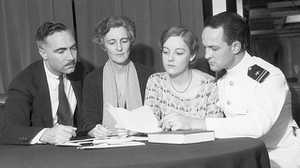Yates Stirling Jr. (1872-1948)

Yates Stirling Jr. was a young boy when he stood on the deck of a United States Navy warship for the first time. An admiral on board asked him if he was going join the Navy like his father. Young Stirling answered, "I hope to, sir."
Navy Boy
Born in 1872 to a naval officer and his wife, Yates Stirling Jr. grew up yearning to experience the excitement of the Navy. Long letters arrived sporadically during his father's two- to three-year sea duty assignments, and young Stirling anxiously awaited these letters, which were full of adventurous stories of exotic people and lands. Nine years after telling the admiral on the warship of his intentions to be in the Navy, Yates Stirling Jr. began classes at the United States Naval Academy in Annapolis, Maryland.
Stationed in Honolulu
Stirling graduated the Academy in 1892 and received his first assignment: a two-year cruise as a "past midshipman" on the cruiser San Francisco, stationed in Honolulu. Upon arrival in the Hawaiian Islands (which were called the Sandwich Islands in geography classes of the time), Stirling was disappointed to find Honolulu not very different from home except for the tropical setting. Stirling did, however, remember one significant difference from his youth in Baltimore, Maryland: "it seemed strange to see a dignified white official surrounded by children with skins as dark as mulatto."
Promotions
By 1930, Stirling had progressed through six ranks in the Navy to become rear admiral. He was assigned commandant of the 14th Naval District, which included both Pearl Harbor and the Hawaiian Islands. Admiral Stirling came into the position with an acute awareness of Hawai'i's strategic value to the United States.
Hawai'i's Strategic Value
Stirling's stance on the vital role Hawai'i played in America's defense planning dated back to 1912, when, as a student at the Naval War College in Rhode Island, he had been asked to prepare an essay on the "Strategy of the Pacific" to be read to officers attending a summer lecture. His essay, "A Military Road Across the Pacific," argued for the necessity of building military facilities across a chain of islands in the Pacific that would allow a war fleet to steam across the ocean without having to stop to refuel, thus giving the Navy the ability to fight a war in Asian waters. Creating a secure military base in Hawai'i was the important first link in this chain.
Eager to Convict
Stirling's racial prejudices, evident in his observations from his first trip to Hawai'i, coupled with his militaristic view of the American territory of Hawai'i, set the stage for his role in the Massie affair. When he first heard Thalia Massie's story of being assaulted by locals from a Navy captain, his infamous reply, "our first inclination is to seize the brutes and string them up on the trees," set the tone for the Navy's attitude toward the case. Though Stirling added, "we must give the authorities a chance to carry out the law and not interfere," it quickly became apparent that carrying out the law to the U.S. Navy really meant securing a quick conviction. When there was no verdict returned and a mistrial declared, Stirling lamented that the trial was "a stupid miscarriage of justice that could have been avoided if the Territorial Government had shown more inclination to sympathize with my insistence upon the necessity of a conviction."
The Unwritten Law
Stirling's obstinate belief that the five men on trial were unquestionably guilty, despite a lack of evidence and no conviction, reinforced the attitude of the Navy men under his command that justice had not been served. Stirling was not surprised when Navy men reportedly beat Horace Ida. He was not surprised when Navy men kidnapped and killed Joseph Kahahawai. He had assumed that someone would invoke what he called "the unwritten law for the crime of rape."
Lessons from the Trial
When Governor Judd commuted the ten-year sentence of Joseph Kahahawai's murderers on May 4, 1932, Stirling was livid that the killers had not been pardoned entirely. He did, however, feel that the community of Hawai'i benefited from the two trials. The police force was restructured and outside political control of the force was reduced. In addition, "the dark-skinned citizens have been taught how far the American white man will go to protect his women."
Pearl Harbor
Admiral Stirling left Hawai'i in 1934 and retired from the Navy before Pearl Harbor was attacked in 1941. His long-time belief that the Japanese would attack America was affirmed, and his assessments as commandant that perhaps Pearl Harbor did not have adequate air defenses made tragically clear. As a man who prepared for war continuously throughout his life, he never trusted non-whites, and he valued the security of America's "Gibraltar of the eastern Pacific" above all else.







